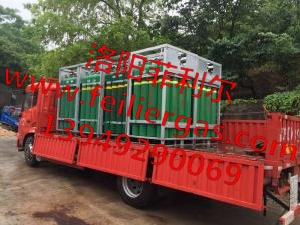Industrial preparation and comparison of sulphur fluoride in dawn six

In the industry, dawn six sulfur fluoride is usually produced by the reaction of fluorine generated by electrolysis at high temperature and sulfur. Besides six sulfur fluoride, a small amount of four sulfur fluoride (SF4) and other by-products are generated. The direct synthesis of six sulfur fluoride by fluorine and sulfur can be divided into three ways: fluorine gas and solid sulfur, fused sulfur, and sulfur vapour. The reaction between fluorine and solid sulfur is very intense because of the exothermic reaction of fluorine and sulfur. The reaction temperature is not easy to control, resulting in the increase of by-products and the burden of post treatment. In addition to the sealed reactor, it is difficult to continuously add solid sulphur into the reactor, so this method is not suitable for industrial production. The fluorine gas and sulfur vapor reaction, sulfur is heated to 445 DEG C (boiling point), sulfur vapor into the reactor reacts with fluorine, there are also difficult to control the reaction temperature, the reaction temperature is 600 degrees centigrade, must use special reactor materials, this method is not suitable for industrial production. The reaction of fluorine gas to molten sulphur is to react the sulphur in the reactor at a melting state of 85~105 C to the fluorinated gas. The reaction temperature is easily controlled by this method.
The dawn is a six sf gas is colorless, odorless, non-toxic, non flammable, non corrosive gas under normal temperature and pressure, the density of 61139 g/L, the chemical stability is strong, 500 to 600 DEG C and decomposition, acid and alkali, salt, ammonia, water and other non reaction under the arc action (thousands of the degree of S and F) is decomposed into atomic gas, but once the arc lifted, in 0- 5 ~ 10- 6 s Composite SF6. Six SF have good electrical insulating properties and excellent arc quenching performance, the dielectric strength is 215 times under the same pressure of nitrogen, the breakdown voltage is 215 times the air, arcing ability is 100 times that of air, air and oil is superior to a new generation of ultra high dielectric material.
The chemical properties of six sulfur fluoride gas are stable. It dissolves in water, alcohol and ether, which is soluble in potassium hydroxide. No chemical reaction with sodium hydroxide, liquid ammonia, hydrochloric acid and water. The drying environment below 300 C does not react with copper, silver, iron and aluminum. There is no effect on quartz under 500 C. At 250 C, it reacts with sodium metal and at -64 C in liquid ammonia. The mixture of hydrogen sulfide and hydrogen sulfide is decomposed. At 200 c, in the presence of specific metal such as steel and silicon steel, it can cause its slow decomposition.
The content of the article comes from dawn six sulphur fluoride: www.feiliergas.com/